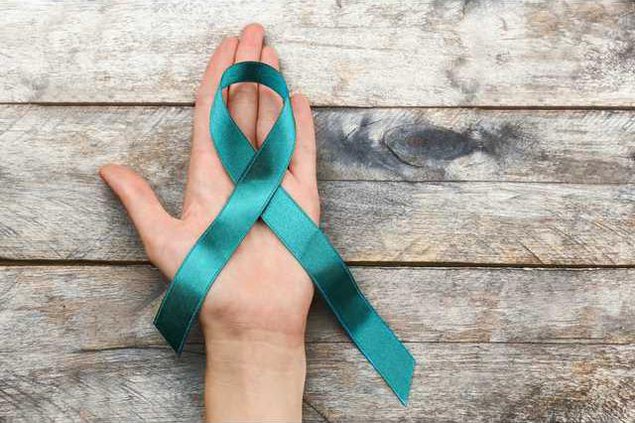Ovarian cancer affects older and younger women when tumors develop from the lining cells of the ovary. It's been estimated that 22,240 women will be diagnosed with ovarian cancer this year 14,070 of those women will pass away from this disease. And according to the Centers for Disease Control and Prevention, its the tenth most common cancer in women.
With statistics this high, it's helpful to educate yourself about its symptoms for yourself, your mom, daughter, or sister:
Types and stages of ovarian cancer
After a doctor diagnoses a woman with ovarian cancer, they will determine what type and stage she has. There are four types of ovarian cancers, with varying types of symptoms and rarity. Epithelial Ovarian Cancer, is the most common of the four, with tumors affecting the ovary, fallopian tubes and the primary peritoneal cancer. This type of cancer also typically affects the serous, mucinous, clear cell and endometrioid cells.
Ovarian Low Malignant Potential Tumor (OLMPT) has tumors which affect the serous and mucinous cells and tend to grow in masses. Fortunately, this type of ovarian cancer rarely spreads to other lymph nodes. The Germ Cell Ovarian Cancer supports tumors from germ cells that begin from the reproductive cells in the ovary. These tumors are rare and tend to affect teens and young adults more than older women.
Lastly, Stromal Ovarian Cancer is uncommon, but the tumors come from the ovary's supporting tissue.
The stages of ovarian cancer are I through IV. Generally, early stages of cancer tend to spread less than later stages, which makes it even more crucial for you to watch your risk factor level and keep and eye out for symptoms.
Risk factors
Studies have shown that theres no way to prevent ovarian cancer. However, there are certain risk factors that affect the chances of being diagnosed.They include the following:
The symptoms of ovarian cancer are hard to detect when in the early stages (and which is when detection is most crucial). Its difficult because your ovaries are hidden deep in the abdominal area.
These are the four symptoms you cannot ignore. If your stomach feels full, tight, and painful, you are bloated. This is often accompanied by excessive gas and burping and stomach rumbles. Combine this with pelvic or abdominal pain ( discomfort or cramps before or during your period or after sex, lower back pain, pain when you urinate or rectal bleeding) and you should be concerned.
Two other symptoms include trouble eating (or feeling full quickly) and urinary issues, like having to urgently urinate often. All these symptoms can cause you to feel fatigued, have frequent stomach aches, back pain, pain during sex and even changes in your menstrual cycle.
You need to see your doctor if these symptoms persist for weeks at a time. Another reason to see your doctor if youve tried to remedy any of the symptoms without success.
At your doctors visit, you can discuss the symptoms youre experiencing and determine if further tests are needed to rule out or confirm an ovarian cancer diagnosis. There are treatment options available. Your healthcare provider can help choose the treatment thats right for you.
With statistics this high, it's helpful to educate yourself about its symptoms for yourself, your mom, daughter, or sister:
Types and stages of ovarian cancer
After a doctor diagnoses a woman with ovarian cancer, they will determine what type and stage she has. There are four types of ovarian cancers, with varying types of symptoms and rarity. Epithelial Ovarian Cancer, is the most common of the four, with tumors affecting the ovary, fallopian tubes and the primary peritoneal cancer. This type of cancer also typically affects the serous, mucinous, clear cell and endometrioid cells.
Ovarian Low Malignant Potential Tumor (OLMPT) has tumors which affect the serous and mucinous cells and tend to grow in masses. Fortunately, this type of ovarian cancer rarely spreads to other lymph nodes. The Germ Cell Ovarian Cancer supports tumors from germ cells that begin from the reproductive cells in the ovary. These tumors are rare and tend to affect teens and young adults more than older women.
Lastly, Stromal Ovarian Cancer is uncommon, but the tumors come from the ovary's supporting tissue.
The stages of ovarian cancer are I through IV. Generally, early stages of cancer tend to spread less than later stages, which makes it even more crucial for you to watch your risk factor level and keep and eye out for symptoms.
Risk factors
Studies have shown that theres no way to prevent ovarian cancer. However, there are certain risk factors that affect the chances of being diagnosed.They include the following:
- Age: Most diagnoses are in women who have been through menopause.
- Obesity: Various studies have shown a correlation between obesity and ovarian cancer. Its concluded that obese women have a higher likelihood of developing ovarian cancer.
- Full-term pregnancy: Women who become pregnant and carry full-term before 26 have a low chance of being diagnosed.
- Birth control: Women who use birth control pills for more than six months have a lower risk of ovarian cancer.
- Fertility drugs: Some researchers have found that fertility drugs increase the risk of developing an ovarian tumor. The risk is higher for women who use the drug and do not become pregnant.
- Family history of ovarian cancer: Ovarian cancer can be hereditary. A womens risk is higher if her mom, daughter or sister has been diagnosed with it. If the family has a history of breast cancer this also increases a womans risk. These types of cancers are caused by an inherited mutated gene.
The symptoms of ovarian cancer are hard to detect when in the early stages (and which is when detection is most crucial). Its difficult because your ovaries are hidden deep in the abdominal area.
These are the four symptoms you cannot ignore. If your stomach feels full, tight, and painful, you are bloated. This is often accompanied by excessive gas and burping and stomach rumbles. Combine this with pelvic or abdominal pain ( discomfort or cramps before or during your period or after sex, lower back pain, pain when you urinate or rectal bleeding) and you should be concerned.
Two other symptoms include trouble eating (or feeling full quickly) and urinary issues, like having to urgently urinate often. All these symptoms can cause you to feel fatigued, have frequent stomach aches, back pain, pain during sex and even changes in your menstrual cycle.
You need to see your doctor if these symptoms persist for weeks at a time. Another reason to see your doctor if youve tried to remedy any of the symptoms without success.
At your doctors visit, you can discuss the symptoms youre experiencing and determine if further tests are needed to rule out or confirm an ovarian cancer diagnosis. There are treatment options available. Your healthcare provider can help choose the treatment thats right for you.








